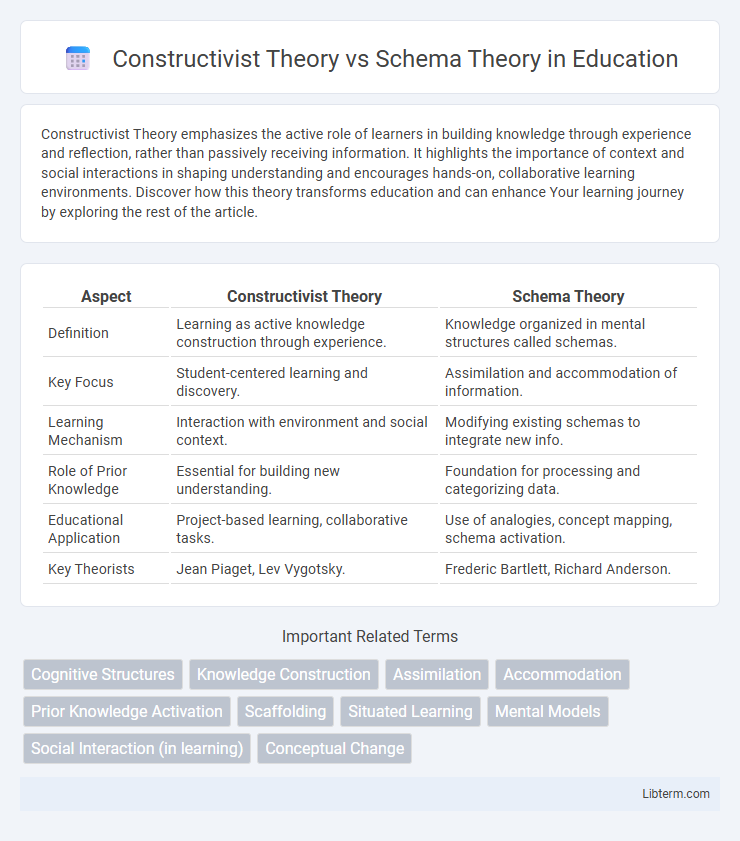Constructivist Theory emphasizes the active role of learners in building knowledge through experience and reflection, rather than passively receiving information. It highlights the importance of context and social interactions in shaping understanding and encourages hands-on, collaborative learning environments. Discover how this theory transforms education and can enhance Your learning journey by exploring the rest of the article.
Table of Comparison
| Aspect | Constructivist Theory | Schema Theory |
|---|---|---|
| Definition | Learning as active knowledge construction through experience. | Knowledge organized in mental structures called schemas. |
| Key Focus | Student-centered learning and discovery. | Assimilation and accommodation of information. |
| Learning Mechanism | Interaction with environment and social context. | Modifying existing schemas to integrate new info. |
| Role of Prior Knowledge | Essential for building new understanding. | Foundation for processing and categorizing data. |
| Educational Application | Project-based learning, collaborative tasks. | Use of analogies, concept mapping, schema activation. |
| Key Theorists | Jean Piaget, Lev Vygotsky. | Frederic Bartlett, Richard Anderson. |
Introduction to Constructivist Theory and Schema Theory
Constructivist Theory emphasizes active knowledge construction through experience and reflection, highlighting the learner's role in creating meaning from interactions with their environment. Schema Theory focuses on the mental frameworks, or schemas, that individuals use to organize and interpret information based on prior knowledge. Both theories underscore the importance of prior experience but differ in constructivism's emphasis on learner-driven discovery versus schema theory's focus on structured cognitive organization.
Historical Background and Development
Constructivist Theory emerged primarily from the works of Jean Piaget in the early 20th century, emphasizing that learners actively construct knowledge through experience and interaction. Schema Theory developed later, rooted in the cognitive psychology research of the 1970s, notably influenced by Frederic Bartlett's concept of mental frameworks that organize information. Both theories evolved to explain knowledge acquisition, with Constructivism focusing on experiential learning and Schema Theory on the role of existing cognitive structures in processing new information.
Core Principles of Constructivist Theory
Constructivist Theory emphasizes active learning through experience, where knowledge is constructed by learners interacting with their environment and reflecting on those interactions. Core principles include the idea that learners build new understanding based on prior knowledge, social collaboration enhances learning, and learning is contextually situated within real-world activities. This theory contrasts with Schema Theory, which focuses more on how information is organized and stored in mental frameworks rather than the dynamic process of meaning-making through experience.
Core Principles of Schema Theory
Schema Theory centers on the idea that knowledge is organized into mental frameworks called schemas, which help individuals interpret and predict information efficiently. These schemas are continuously modified through assimilation and accommodation as new experiences are encountered, enabling adaptive learning. The theory highlights the importance of prior knowledge in shaping understanding and guiding the processing of new data.
Key Theorists and Influential Works
Key theorists of Constructivist Theory include Jean Piaget, whose seminal work "The Origins of Intelligence in Children" laid the foundation for understanding cognitive development through active learning processes. Schema Theory was prominently advanced by Frederic Bartlett with his influential book "Remembering: A Study in Experimental and Social Psychology," emphasizing mental frameworks for organizing knowledge. Both theories profoundly shaped educational psychology by highlighting the interaction between learners' experiences and pre-existing cognitive structures.
Learning Processes: Constructivism vs Schema Theory
Constructivist Theory emphasizes active learning where learners build knowledge through experiences and social interactions, fostering deep understanding and critical thinking. Schema Theory focuses on how information is organized into mental frameworks or schemas, facilitating new knowledge assimilation and retrieval based on prior knowledge structures. Both theories underscore the importance of meaningful connections in learning but differ in their approach to how knowledge is constructed and integrated.
Classroom Applications and Educational Strategies
Constructivist Theory emphasizes active learning where students build knowledge through hands-on experiences and social interaction, promoting strategies like collaborative projects and inquiry-based learning. Schema Theory focuses on how prior knowledge structures influence comprehension and memory, guiding educators to use advance organizers, analogies, and scaffolding to connect new information to existing schemas. Integrating both theories enhances classroom instruction by fostering deep understanding and meaningful knowledge construction tailored to individual learner backgrounds.
Similarities and Differences: A Comparative Analysis
Constructivist Theory and Schema Theory both emphasize active knowledge construction, where learners build understanding by integrating new information with prior experiences. Constructivist Theory prioritizes learner-centered environments promoting discovery and collaboration, while Schema Theory focuses on mental frameworks organizing prior knowledge to interpret new data. Both theories support the importance of prior knowledge in learning but differ in approach; Constructivism is experiential and social, whereas Schema Theory is cognitive and structural.
Advantages and Limitations of Each Theory
Constructivist Theory emphasizes active knowledge construction through experience, promoting deep understanding and critical thinking but may struggle with providing structured guidance for novice learners. Schema Theory highlights the importance of existing cognitive frameworks in organizing and interpreting information, facilitating efficient learning and recall, yet it can be limited by learners' pre-existing misconceptions and difficulty in assimilating radically new information. Both theories offer valuable insights into cognitive development, with Constructivism fostering engagement and Schema Theory enhancing memory integration.
Implications for Modern Teaching and Learning
Constructivist Theory emphasizes active learner engagement and knowledge construction through experience, fostering critical thinking and problem-solving skills essential for modern classrooms. Schema Theory highlights the role of prior knowledge structures in organizing new information, guiding teachers to design lessons that connect new content to existing cognitive frameworks. Integrating both theories supports personalized learning strategies that enhance comprehension and long-term retention in diverse educational settings.
Constructivist Theory Infographic

 libterm.com
libterm.com